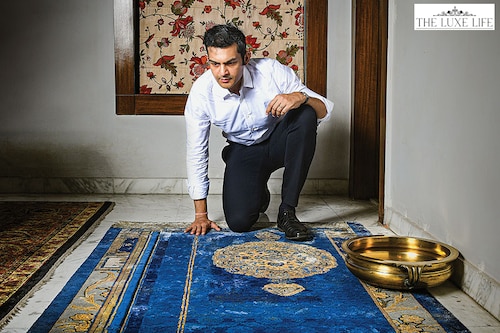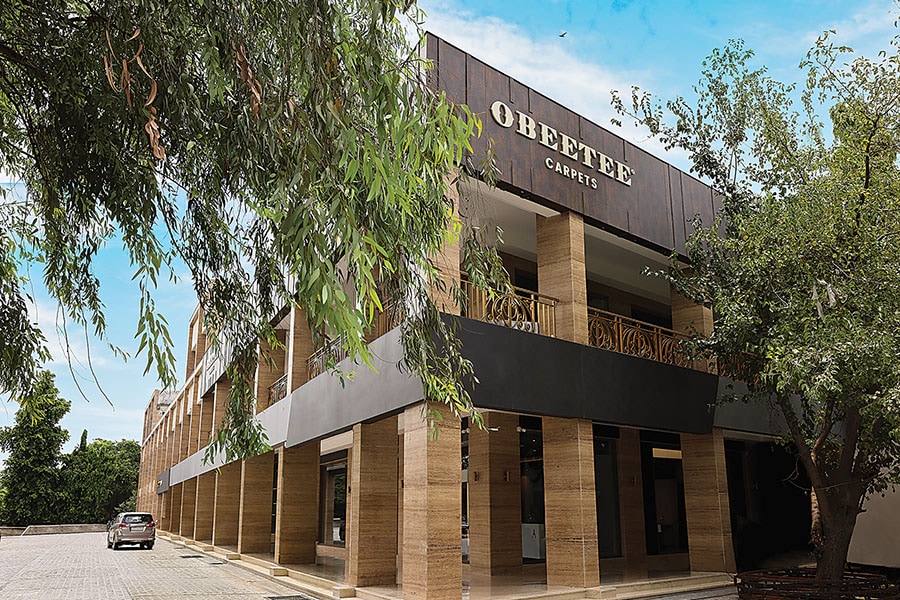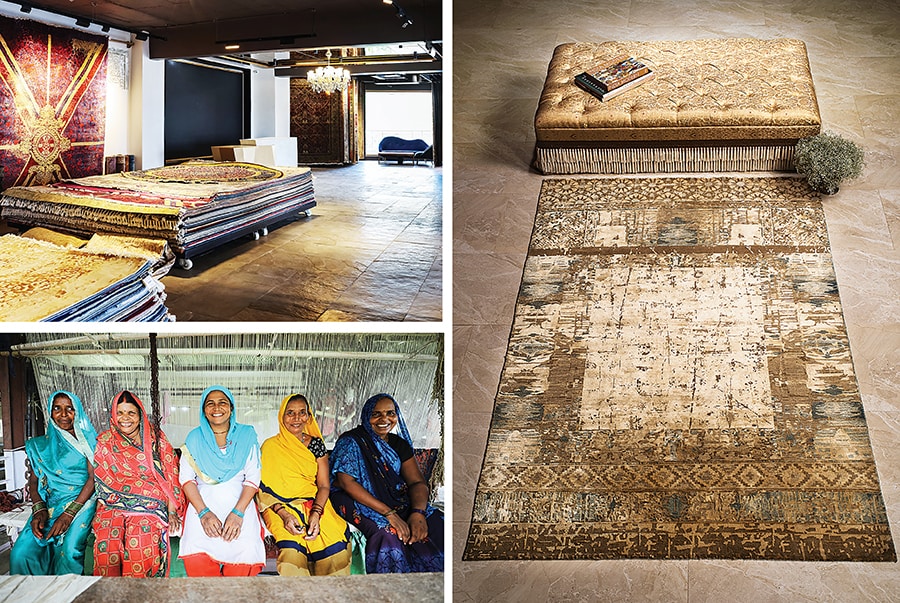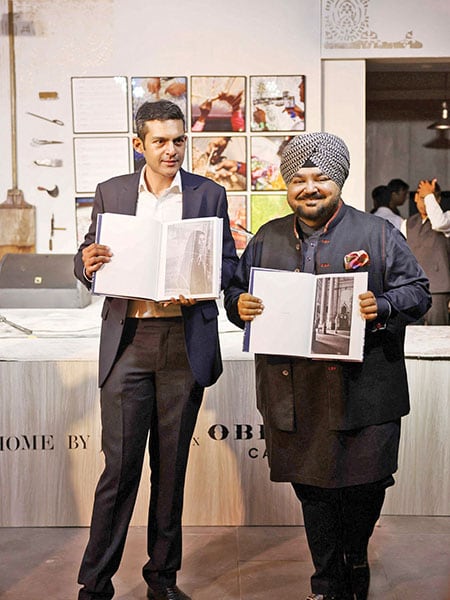How the 101-year-old Obeetee is redefining weaves and carpets for Indian homes
One of the world's largest and oldest maker of luxury handmade carpets is now bringing the rich heritage of India's weaves to homes here


“The Obeetee carpet at the Rashtrapati Bhavan, and how it found its way there, should be a part of design history," says Rudra Chatterjee, managing director of the Rs 1,000-crore, Kolkata-based Luxmi Group, and chairman of Obeetee, its sister company. “The Rashtrapati Bhavan was built around the same time that Obeetee was founded, and so, very early on, the brand put its stamp on the grandest home in India. I have also found Obeetee carpets in the residential wing—not the commercial wing—of Umaid Bhavan in Jodhpur."
But this is not the story Chatterjee is telling his customers, as the 101-year-old brand—it makes 3 million sq yards of rugs a year—has turned its focus for the first time to the retail sector in India, alongside its thriving, Rs 700-crore export market. Instead, he is focusing on how carpets can add a touch of individuality to Indian homes, at a time when “it is becoming more and more difficult to tell one urban residence from the other all of them have the same marble floors, glass facades and abstract paintings on the walls. Our campaign, ‘Add life to your home’ says that Obeetee will create carpets that talk to your individuality, whatever that might be".
Chatterjee highlights that the biggest character of an Indian home is its inclusivity. “Many of us live in joint families, and we have areas of the home in which we read newspapers or study or watch television. And while we live together, we have different corners of the home, where our individuality comes out: So there might be reggae-inspired designs from Trinidad, in another part you have Persian influences, and yet in another, you have a prayer mat. That is what Obeetee wants to focus on," he says.
Founded by FH Oakley, FH Bowden and JAL Taylor (the initials of their surnames becoming OBT) in 1920, the company is one of the world’s largest and oldest to make handmade rugs and carpets. It employs over 30,000 carpet weavers—many of them being fifth and sixth generation weavers working from their own looms or homes—from 900 villages in and around Uttar Pradesh’s (UP)Bhadohi and Mirzapur districts. Its century-old legacy combines cutting-edge design—for which it has also partnered with Parsons School of Design—with deep-rooted traditional craftsmanship.
With 90 percent of its revenues coming from retailers and enterprise clients in the US, Obeetee has an office in New York. Clients in the hospitality sector include boutique hotels such as New York’s Sheraton Brooklyn, Soho House and Beekman Hotel, and design outlets such as Michael Kors’ retail stores.
“As Obeetee was about to complete 100 years, we felt our celebrations should also have some resolutions," says Chatterjee. “We started by wanting to have designs that represent our culture, from different parts of India: We are from Bengal, our weavers are from UP and Rajasthan, our wool comes from Amritsar." Therefore, from 2016 onwards, the company started a campaign called ‘Proud to be India’, which showcased the rich design traditions of India and roped in some of the biggest Indian designers, such as Raghavendra Rathore, Abraham & Thakore, JJ Valaya, Anju Modi and Tarun Tahiliani to produce unique pieces.
“India has very interesting design sensibilities, which are not pan-Indian," explains Chatterjee. “There is a very different look to designs of chikankari from UP or tie-and-dye motifs from Ahmedabad or the Patiala theme or the Indian military history, which inspired designers Shantanu and Nikhil. So, the individuality of the customer should go hand-in-hand with regional individuality."
“These days, one of the things we forget is that we, as Indians, have always been a textile industry we did beautiful weaves, ornamentation and embroidery," says designer Tarun Tahiliani. “Working with Obeetee was the first time we did carpets, but we have been working with textiles for many years. Technically, carpets are different, but they lead from what we do with ornamentation and surface embellishments, which is such an integral part of our heritage and our design label."
“When we started our first Indian collection with Tarun Tahiliani, we were thinking of creating designs that were India-centric," says Angelique Dhama, marketing head, Obeetee. “India is such a large manufacturer of handmade carpets, and everything was going to the West. The best of the best was all going to beautiful homes in the US, the UK and rest of the world, and nothing stayed in India." The brand, therefore, decided to launch a range of carpets in India that would be top-of-the-line and which would document Indian designs in rug making. “Most designs in rug making are Persian or Indo-Nepalese or Indo-Tibetan, but not Indian. So we started the process of creating carpets with Indian design sensibilities."
Image: Qbeetee
Along with the opportunity of working with Indian designs, Tahiliani also found Obeetee’s sustainable approach to the craft very appealing. “Everything I do, and especially so after the pandemic, I try to keep traditions alive and give craftsmen their dignity. When I visited Obeetee’s workshops in Mirzapur, it was quite incredible to see the working conditions of the weavers some of the work is done in villages and not in factories. This is a company that is commercially very successful, it has taken a centuries-old craft, organised it, has given the workers the dignity they deserve, and created good working conditions that are close to home, so that they don’t have to become migrants in big cities, which creates a whole lot of social and financial difficulties."
He adds the example of Obeetee’s centres In Lucknow, the home of chikankari, which is mostly done by women. “There were crà¨ches for babies, and the women got a dignified salary and could look after their children as well," says Tahiliani. “Obeetee ticked off all the boxes for me."
 Obeetee launched its first store in Delhi in 2019. It also has a store in Mumbai
Obeetee launched its first store in Delhi in 2019. It also has a store in Mumbai
Obeetee also works with NGO Pratham, which works in the area of children’s education, and has collaborations with MIT’s Poverty Action Lab, which trains women in weaving carpets. “Indian customers also have to understand that these carpets are made by Indian weavers who are our first responsibility," says Chatterjee. “We hope Indian customers will recognise that this is a brand that is part of our own community."
Obeetee launched its first store in Delhi in end-2019, but the Covid-19 pandemic accelerated its plans to launch in India, as people began to spend more time at home, and residences became a very important expansion category. “We still wanted to work with the hospitality sector, where we are very strong. All the Oberoi hotels are done by us, whether in India or Marrakesh or anywhere in the world we do the Taj, Leela and Marriott hotels as well," says Dhama. “The plan was to open stores in India, but more like experiential centres, and have six to seven stores over the next three years." So far, the company has two stores—one in Delhi and one in Mumbai.
 Obeetee stores, like the one in Delhi, serve as experience centres, with the most exclusive white-glove service Windswept, a hand-knotted silk-and-wool rug—part of the Abstract Art collection by Tarun Tahiliani for Obeetee weavers at the Obeetee factory in Mirzapur, Uttar Pradesh. The company has given the workers the dignity they deserve
Obeetee stores, like the one in Delhi, serve as experience centres, with the most exclusive white-glove service Windswept, a hand-knotted silk-and-wool rug—part of the Abstract Art collection by Tarun Tahiliani for Obeetee weavers at the Obeetee factory in Mirzapur, Uttar Pradesh. The company has given the workers the dignity they deserve
Chatterjee adds that the brand is very strong digitally, and has online sales for all its designer rugs as well. “But it is important to feel not only a beautiful product but also a beautiful service and hospitality," he adds. “It is a struggle to do it online, but we have white-glove service for online customers as well, where someone will deliver the carpets to your home in beautiful wooden boxes."
Designing for the retail client in India has been an entirely different process, when compared to working with export clients. “The hat that we wear while making for the Indian customer is very different from the one we wear while exporting," says Chatterjee. Elaborating on this difference in approaches, Dhama says, “We have been product developers for the export market. Our biggest customers, like Pottery Barn, come to us with a mood board, and say this is going to be our collection, and how would you interpret the rugs for it? For India, we are conceiving our own mood boards. Like we have a collection called ‘Obvious Luxury’ or ‘Bohemian’. The product categories and colours are very different from what we export we have seasonal and regional products."
Obeetee stores—they account for 75 percent of sales—serve as experience centres, with the most exclusive white-glove service. The walls of the Worli store in Mumbai, for instance, are draped with luxurious carpets that, from a short distance, could well be mistaken to be the richest weaves of sarees. With a spectrum of designs that range from those inspired by Mughal miniatures to modern abstracts, and materials that range from the most luxurious of silks to the softest of wools, and with knots that vary from the most dense and intricate to the most simple, the carpets and rugs come in a multitude of sizes and can be used in a variety of rooms. True to what Chatterjee claims, you can well imagine the smaller ones, with fun, bright and playful designs, to be in child’s rooms, while the larger, more luxurious ones as a centrepiece in a living room. The staff, with many years of experience in the sector, are a storehouse of knowledge, with suggestions and answers for any query you might have.
“Our designers can go to your homes, and suggest ways in which you can mix and match the rugs into your decor," Dhama says. “We have collaborations with stores that deal with antique furniture or silver or cafes of five-star hotels in tier 2 cities or in the Taj Khazanas [luxury lifestyle stores in Taj hotels], from where international travellers can take back memoirs of India. So we are trying to attract different kinds of retail customers."
First Published: Oct 28, 2022, 12:45
Subscribe Now Rudra Chatterjee (left),MD, Luxmi Group, and chairman of Obeetee, with designer JJ Valaya launching the JJ Valaya collection in September.
Rudra Chatterjee (left),MD, Luxmi Group, and chairman of Obeetee, with designer JJ Valaya launching the JJ Valaya collection in September.